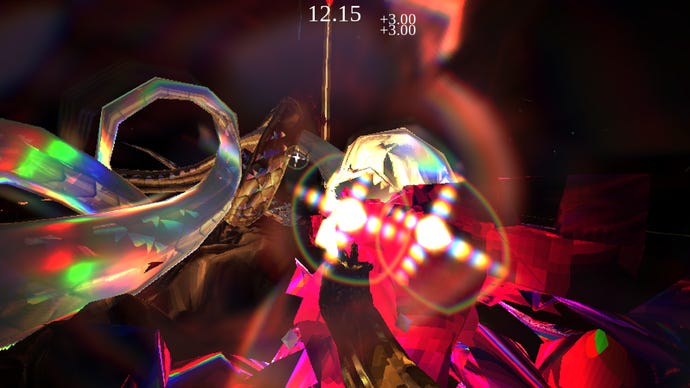Why Hyper Demon's devs suggest you slow down to speed up
Too fast = too furious
Devil Daggers was fantastic, Hyper Demon is better. The sequel to Sorath's exquisite wave survival FPS flips a slow-building, protracted struggle into a hyperdense spurt of action that escalates in lockstep with your abilities, thanks to enemies that spawn the moment you've dispatched their chums and a score that ticks down with every second you spend not actively murdering.
That structure is also a trap. It’s an invitation to devise an opening dance that dispatches those first few waves as quickly as possible, yet following that dance too rigidly will crash you headfirst into a bonespire. Hyper Demon screams at you to go fast - though when I asked programmer Matt Bush for tips, he suggested I slow down.
Here’s how I do it:
I stream daggers at the first spawner, timing my last shot so the craggy mass disintegrates moments after it appears. Another blast takes down the gem it leaves behind, splitting it into smaller gems that I immediately bounce against the floor to form a tri-shot laser levelled at the three flying beetles. A three dash combo finishes them off as they wiggle on the floor, chained into a ground-pound that, if I do it just right, instantly takes out the triple-headed skull snake. On a good run, all of that takes me about ten seconds.
Matt Bush can do so much more. What I first took to be a slight tweak to my formula are just the first steps that launch him into a hurricane of destruction. It turns out you can kill that first spawner “almost instantly”, Bush says,“by firing daggers while moving toward it, then dashing and firing a shot at the last second”. That means “all the daggers will bunch up and hit right as it materialises - not quite as fast as dashing through the big gem, but it lets you keep the gem for later.”
For the most part, though, Bush reckons Hyper Demon is “pretty easy to follow once you understand the core mechanics and a few tricks.”
Watch this, though. See how Bush does indeed vaporise the spawner, but then catapults himself into the sky, smushes all the enemies in a flurry of blasts and groundpounds,then lasers a floating bomb-spewer - consistently managing to kill more or less everything in the same instant it spawns in. It’s humbling, watching someone who truly knows what they’re doing in Hyper Demon. They appear as psychic orchestra conductors, lining up enemies and gems in patterns that beget optimal destruction. It can be hard to comprehend - even for Bush, sometimes, who told me he’s seen a few clips that he had to “slow right down to figure out what was going on”.
For the most part, though, Bush reckons Hyper Demon is “pretty easy to follow once you understand the core mechanics and a few tricks.” Maybe that’s part of why the world’s best players are already surpassing Bush’s expectations. “After seeing how far Devil Daggers has been pushed, I shouldn't be surprised,” he says, “but I really didn't think the top scores would be approaching 400 this soon.”
I can just about wrap my head around what’s happening in this clip, and I’ve seen glimpses into how runs like that must feel to execute. Few other games have plunged me into flow states so effectively. Jon Marshall, who worked on art and design, recognised the trance state I was talking about, and I like his succinct explanation for how Hyper Demon casts its spell: “the trance induction comes from repetition and the way the dynamic difficulty creates game flow: most of the time you are at your edge which puts you into a heightened state.”


It’s a superb bit of design. Not just the way scoring encourages me to come up with an opening that must be practised, tweaked on the fly, then ultimately abandoned when I get far enough into a run that I have to rely on my wits alone. The real kicker is that the more I dance that opening dance, the deeper the groove it carves on my mind, and so the harder it becomes to haul myself out of it. Every second I spend in Hyper Demon feels like a second where I could be doing more, and watching better players rubs that in. Those runs, though, contain the key to further success; they’re an invitation to innovate, or at least to copy other people’s tricks. Once deciphered, they showcase specific ways of taking down certain enemies, or new paths you can weave between enemy types.
When I asked Bush specifically how he designed the opening, he said “we focused on making each enemy fun to fight on its own, and making different combinations of enemies fun to chain together. Crafting the first 10-20 seconds was just a matter of introducing the enemies in a way that makes sense.” The prime example? “Having the spawner appear first gives you the most movement and weapon options to get the run started.” Options. So many options.

I haven’t properly explored them. “Focusing on score too early seems to trip people up,” Bush told me, and I count myself as one of the tripped. I’d been lured into running before I can even bunny hop. As Bush puts it, “there's a lot to learn, so I think it's worth spending some time experimenting, either in training or just playing the game at a slower pace. As you understand more elements and how they fit together, you can start to approach the game in a way that will naturally result in a higher score.”
It’s funny that chatting to the developers is what I needed to break out of the spell their own game casts. I’m trying new things. I can zap a floaty bomb-spawner from underneath, now, and I’m beginning to appreciate the value of occasionally stomping atop the spawners to trigger a gem rush. Most importantly, I’m consciously taking a break from that opening dance, experimenting while I figure out new steps to add to it.
It’s a case study in how to avoid single-minded, tunnel-visioned score chasing and instead embrace flexibility - both while executing an opening, and approaching runs with different mindsets and at different speeds. If you really want to get where you’re going, sometimes you gotta slow down.



